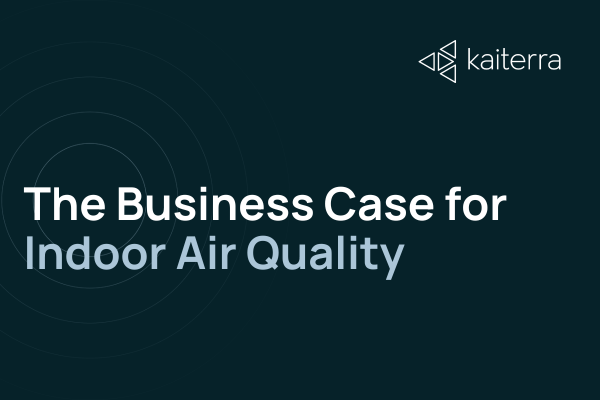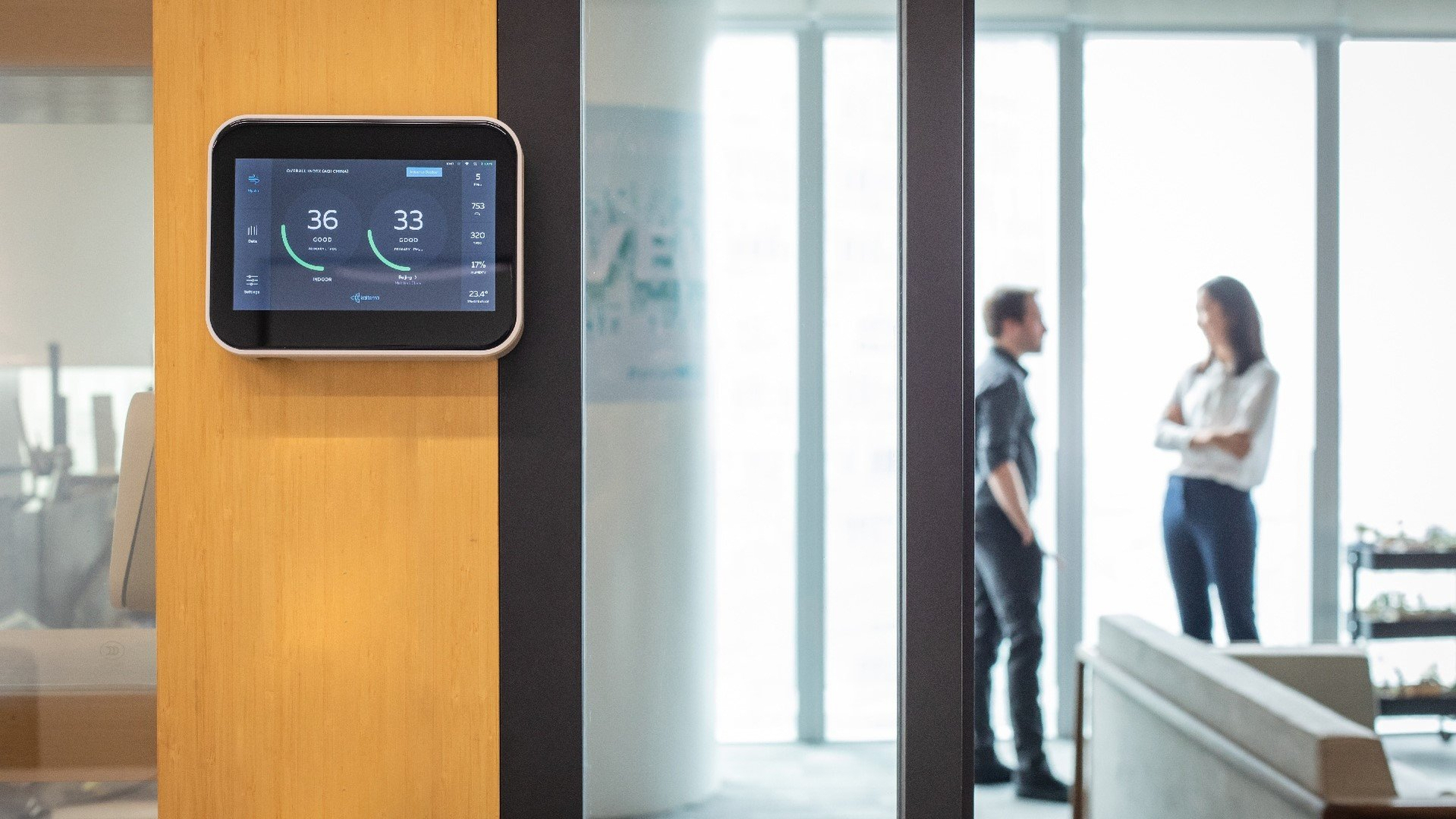Newsletter
The Leadership in Energy and Environmental Design (LEED) certification is the most globally recognized green building standard, with over 100,000 certified projects worldwide. The LEED certification has gone through several iterations over the past three decades, with the most recent version, LEED v5, released in April of 2025.
Compared to its predecessor, LEED v4.1, LEED v5 adopts a more data-driven, human-centric approach to green building. LEED v5 includes several healthy building initiatives, most notably indoor air quality (IAQ), to help create buildings that are not only energy efficient but also designed to support occupant health and well-being.
In this article, we’ll look at how LEED v5’s approach to IAQ is different from LEED v4.1, discuss LEED v5’s requirements in detail for all three types of certification (O+M, BD+C, and ID+C), and provide practical implementation guidelines to help LEED v5 projects maximize their points with continuous IAQ monitoring.
How Is Indoor Air Quality in LEED v5 Different From LEED v4.1?
The major difference between LEED v4.1 and LEED v5 is the higher number of points awarded for real-time, continuous monitoring of IAQ. LEED v5 O+M projects can earn up to 10 points with continuous IAQ monitoring, compared to just 4 points for periodic spot testing in LEED v4.1 O+M. This is great news, as continuous monitoring offers a much easier and less time-consuming way to achieve maximum points for IAQ than one-time air testing.
Another key difference is the stronger focus on data in LEED v5. LEED v4.1 only required projects to measure a limited number of air quality parameters once a year, resulting in substantial data gaps around IAQ. LEED v5 aims to close those gaps by incentivizing continuous, real-time monitoring of key IAQ parameters.
To recap, here’s a summary of the key differences between LEED v5 and LEED v4.1 for IAQ:
| LEED v4.1 O+M | LEED v5 O+M |
| Up to 4 points for periodic spot testing | Up to 10 points for continuous IAQ monitoring |
| A limited range of IAQ parameters is measured | PM2.5, CO2, and TVOC are measured |
| Annual readings offer an incomplete picture of IAQ | Relies heavily on continuous, accurate & real-time data |
Indoor Air Quality Monitoring Requirements in LEED v5
LEED v5 offers three different types of certification, depending on the type of project:
- Operations and Maintenance (O+M), for existing buildings that require little to no construction
- Building Design and Construction (BD+C), for new constructions, additions, or major renovations of a whole building
- Interior Design and Construction (ID+C), for commercial interior fit-out projects in existing buildings
Within each certification is a set of major categories, each with a subset of prerequisites (required) and credits (optional, but provide points). The IAQ requirements in LEED v5 are found in the Indoor Environmental Quality (EQ) category for all three types of certification.
The EQ category has always centered around creating healthy and comfortable spaces, but LEED v5 has taken this goal to the next level. Now more than ever, the EQ category prioritizes human health by emphasizing data-driven performance verification and real-world outcomes over prescriptive design intent.
In short, this means LEED v5 projects must prove that their buildings are doing what they’re designed to do and maintaining a healthy indoor environment. This shift puts an even greater emphasis on taking air quality measurements, especially with continuous IAQ monitors that provide real-time data. Let’s take a closer look at the air quality monitoring and testing requirements in each LEED v5 certification.
IAQ Monitoring in LEED v5 O+M Certification
EQ Credit: Indoor Air Quality Performance (Up to 10 Points)
The goal of this credit is to support IAQ awareness and identify opportunities for improvement in order to enhance occupants’ health, well-being, and comfort.
This credit is the largest update in LEED v5 relating to IAQ monitoring, and something that should get every LEED project excited! There are 10 possible points that can be achieved through any combination of the following three options (note that all 10 points can be achieved through continuous monitoring alone, which automatically takes projects to the next level of certification):
Option 1. Continuous Indoor Air Monitoring (1-10 Points)
For this option, LEED v5 projects can install continuous monitors that measure CO2, PM2.5, and TVOC to earn up to 10 points toward their certification. You automatically earn 2 points for each parameter just by measuring it, but you can earn up to 4 additional points by meeting certain concentration thresholds for CO2 and PM2.5.
| Parameter | Benchmark | LEED Points |
| Carbon dioxide (CO2) | > 1000 ppm | 2 |
| 1000 ppm | 3 | |
| 800 ppm | 4 | |
| PM2.5 | > 15 µg/m3 | 2 |
| 15 µg/m3 | 3 | |
| 12 µg/m3 | 4 | |
| TVOC | Any level | 2 |
The key takeaway here is that using a continuous air quality monitor that measures CO2, PM2.5, and TVOC and achieving the lowest thresholds for these parameters can deliver the maximum 10 points for this credit. These thresholds generally align with WELL v2. Note that a RESET or UL2905-certified monitor must be used for this option.
The remaining options in this credit, Options 2 and 3, use annual spot checks of air quality, instead of continuous monitors, to determine whether or not projects are meeting thresholds. While this verification method contributes points, the point potential is limited (a total of 5 points between Options 2 and 3, versus 10 points from Option 1), and projects will lack the continuous data needed to make informed decisions about their building.
Compared to continuous monitoring, one-time air testing is a low-point strategy that projects should only resort to if they are unable to max out their points from continuous monitors (if they don’t meet the lowest thresholds for PM2.5 or CO2). Projects should rely on Option 1 for most, if not all, points in this credit, only using one-time testing as a backup option.
Option 2. Targeted One-Time Air Testing (1-3 Points)
Projects can earn up to 3 points in Option 2 by conducting an annual air quality test and meeting the minimum IAQ limits (using outdoor air quality readings as a reference). Both laboratory-based and direct-read test methods are allowed. Projects earn 1 point by testing and meeting the minimum limit for every two parameters in the table below, for a grand total of 3 points from six parameters.
| Parameter | Concentration limit (µg/m3) |
| Carbon monoxide (CO) | 9 ppm and no more than 2 ppm above outdoor levels |
| Particulates: PM10 |
ISO class 8 or lower per ISO 14644-1:2015 OR Meet 50 µg/m3 |
| Particulates: PM2.5 |
ISO class 8 or lower per ISO 14644-1:2015 OR Meet 12 µg/m3 OR For projects located in an area where the national standard for PM2.5 is exceeded, meet 35 µg/m3 Note: Cannot earn points if already continuously monitoring |
| Ozone | 0.07 ppm |
| Nitrogen dioxide (NO2) | 40 µg/m3 (21 ppb) |
| TVOC | Any level (Cannot earn points if already continuously monitoring) |
Option 3. Targeted One-Time Individual Volatile Organic Compounds Testing (2 Points)
Option 3 offers 2 points for projects that test for all volatile organic compounds (VOCs) in the table below at least once per year in an accredited laboratory and demonstrate that no VOCs exceed their concentration limit. Note that all thresholds have to be met for every compound in order to earn the 2 points. If any compound is not tested or if any threshold is not met, then projects do not get any points for this option.
| Contaminant (CAS#) | Concentration limit(µg/m3) |
| TVOC | Investigate and take corrective action if levels exceed 500 µg/m3 |
| Formaldehyde 50-00-0 | 20 µg/m3 (16 ppb) |
| Acetaldehyde 75-07-0 | 140 µg/m3 |
| Benzene 71-43-2 | 3 µg/m3 |
| Hexane (n-) 110-54-3 | 7,000 µg/m3 |
| Naphthalene 91-20-3 | 9 µg/m3 |
| Phenol 108-95-2 | 200 µg/m3 |
| Styrene 100-42-5 | 900 µg/m3 |
| Tetrachloroethylene 127-18-4 | 35 µg/m3 |
| Toluene 108-88-3 | 300 µg/m3 |
| Vinyl acetate 108-05-4 | 200 µg/m3 |
| Dichlorobenzene (1,4-) 106-46-7 | 800 µg/m3 |
| Xylenes — total 108-38-3, 95-47-6, and 106-42-3 | 700 µg/m3 |
IAQ Monitoring in LEED v5 BD+C and LEED v5 ID+C Certification
There are two versions of the BD+C certification in LEED v5: Core and Shell and New Construction, depending on the scope of the project. The BD+C: Core and Shell certification applies to projects that have only constructed and designed the exterior core and shell systems (the base building), not interior tenant spaces. The BD+C: New Construction certification is for new builds or major renovations that include the interior of the building.
In LEED v5, continuous IAQ monitoring only comes into play for BD+C: New Construction projects due to both exterior and interior spaces being available for certification. For projects pursuing LEED v5 ID+C certification, the air quality monitoring requirements and points are the same as for BD+C: New Construction projects, and both are found in the Air Quality Testing and Monitoring credit.
EQ Credit: Air Quality Testing and Monitoring (Up to 2 Points)
The intent of this credit is to optimize IAQ management and help projects find new opportunities to make building operations and design more health-focused. There are two options to achieve the maximum of 2 points for this credit, one of which can be earned by installing continuous air quality monitors.
Option 1. Pre-Occupancy Air Testing (Up to 2 Points)
Once construction has been completed and the building is able to maintain ventilation conditions that are typical during expected occupancy levels, a baseline IAQ test is performed before occupants enter the building. The number of measurements ranges from 1 to 10, depending on the total occupied floor area of the building.
The first path (1 point) you can take is measuring particulate matter and inorganic gases over an 8-hour period, using either an ISO-accredited laboratory or a direct reading instrument to calculate peak concentrations for CO, PM10, PM2.5, and ozone.
The second path (1 point) is testing an air sample for VOCs in an ISO-accredited laboratory to ensure each compound remains within the required concentration limit and the TVOC level remains below 500 µg/m3. If any parameters exceed their prescribed limits, the problem must be fixed, and the building has to be retested before the point is earned.
Option 2. Continuous Indoor Air Monitoring (Up to 1 Point)
In addition to (or instead of) performing spot-checks in Option 1, buildings can install IAQ monitors that continuously measure CO2, PM2.5, TVOC, temperature, and relative humidity. These monitors must be RESET or UL2905-certified and installed 3-6 feet above the floor.
While the point potential from continuous monitoring is lower than from one-time testing, the long-term benefits of having continuous, real-time IAQ data make this option a strategic choice for LEED v5 projects.
Continuous data is superior to a one-time measurement, helping projects gain a complete picture of their building operations, identify trends, surface issues, evaluate the impact of optimizations, and ultimately create a healthier indoor environment for their occupants.
How to Achieve Maximum Points for IAQ Monitoring in LEED v5
To recap, here’s a quick summary of how to secure the maximum number of points in each LEED v5 certification with continuous air quality monitors.
| LEED v5 O+M | LEED v5 BD+C; LEED v5 ID+C |
| Install continuous IAQ monitors that measure CO2, PM2.5, and TVOC to achieve 6 points, and meet the lowest thresholds for CO2 and PM2.5 to achieve an additional 4 points, for a grand total of 10 points. | Install continuous IAQ monitors that measure CO2, PM2.5, TVOC, temperature, and relative humidity to achieve 1 point. |
LEED v5 Requirements for Continuous Indoor Air Quality Monitors
LEED v5 has specific requirements for IAQ monitor technical specifications, density, and placement that projects must comply with in order to gain points for continuous monitoring.
LEED v5 Technical Specifications for IAQ Monitors
Projects must choose a continuous monitor that:
- Measures CO2, PM2.5, and TVOC (temperature and relative humidity are also required for BD+C and ID+C projects)
- Meets or exceeds industry quality standards like RESET Grade B105 or UL 2095 Grade B
- Meets the data reporting frequency requirements of every 15 minutes for CO2 and every hour for PM2.5 and TVOC
LEED v5 Density Requirements for IAQ Monitors
To ensure accurate and comprehensive air quality readings, LEED v5 projects must follow these density guidelines:
- Entry Point Density: One monitor per 25,000 sq ft (2,500 sq m)
- Best Practice Density: One monitor per 5,000 sq ft (500 sq m)
While installing monitors at the entry point density is technically compliant with LEED’s requirements, a higher density will provide the quality of data and representative coverage that projects need to make informed decisions for building operations.
LEED v5 Placement Requirements for IAQ Monitors
In addition to installing at the right density, LEED v5 projects must also meet the following placement criteria:
- Regularly occupied spaces, covering different space types, floors, and ventilation systems
- Spaces where the highest concentrations of contaminants are likely to occur
- Spaces that are occupied by at-risk populations or are designated for cleaner air
- In the breathing zone (3-6 ft / 0.9-1.8 m above the floor), more than 3 ft (0.9 m) away from doors, windows, air outlets, stoves, printers, or other influences on air quality readings
Maximize Your IAQ Points in LEED v5 with Kaiterra's Continuous Air Quality Monitors
Whether you’re working on a new construction or certifying an existing building or space, Kaiterra can help you meet all air quality requirements and earn up to 10 points with our suite of wired and wireless continuous air quality monitors.
Our solutions are designed to help LEED v5 projects reduce the time, costs, and work required to achieve the maximum number of points for IAQ.
| Certification | Credit | Parameter | Kaiterra Compliance | Points |
|
LEED v5 O+M: Existing Buildings |
Indoor Air Quality Performance Credit Option 1. Continuous Indoor Air Monitoring |
PM2.5 | ✅ | 2-4 |
| CO2 | ✅ | 2-4 | ||
| TVOC | ✅ | 2 | ||
| TOTAL: 10 POINTS IN LEED v5 O+M WITH KAITERRA | ||||
|
LEED v5 BD+C: New Construction LEED v5 ID+C: Commercial Interior |
Air Quality Testing and Monitoring Option 2. Continuous Indoor Air Monitoring |
PM2.5 | ✅ |
1 |
| TVOC | ✅ | |||
| CO2 | ✅ | |||
| Temperature | ✅ | |||
| Relative Humidity | ✅ | |||
| TOTAL: 1 POINT IN LEED v5 BD+C & ID+C WITH KAITERRA | ||||
LEED projects that partner with Kaiterra receive end-to-end support on their journey to certification:
- In-house LEED APs for air quality & LEED consulting
- Dedicated Customer Success Managers
- Sensor mapping and floor plan review
- Remote installation and deployment support
- Data validation and calibration support
- Supported IWMS and BMS integration
- Quarterly air quality performance reviews
Ready to get started? Connect with a LEED AP on the Kaiterra team to learn more about how our monitoring solutions can help you earn more points with less work in LEED v5!






.png?width=200&height=148&name=Menu%20C%20(2).png)

.png)





